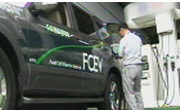암모니아는 지구 온난화의 주범인 이산화탄소 배출이 없는 선박용 친환경 연료이다. 그러나 암모니아는 독성가스이면서 동시에 폭발성 및 부식성 가스로서, 선박용으로 사용되려면 누출에 ...
http://chineseinput.net/에서 pinyin(병음)방식으로 중국어를 변환할 수 있습니다.
변환된 중국어를 복사하여 사용하시면 됩니다.
- 中文 을 입력하시려면 zhongwen을 입력하시고 space를누르시면됩니다.
- 北京 을 입력하시려면 beijing을 입력하시고 space를 누르시면 됩니다.

암모니아 누출 시 선박 연료 준비실의 환기 특성 분석 = Analysis of Ventilation Characteristics in Ship Fuel-Preparation Rooms During Ammonia Leakage
한글로보기https://www.riss.kr/link?id=A109243566
- 저자
- 발행기관
- 학술지명
- 권호사항
-
발행연도
2024
-
작성언어
Korean
- 주제어
-
등재정보
KCI등재
-
자료형태
학술저널
- 발행기관 URL
-
수록면
490-498(9쪽)
- DOI식별코드
- 제공처
-
0
상세조회 -
0
다운로드
부가정보
국문 초록 (Abstract)
암모니아는 지구 온난화의 주범인 이산화탄소 배출이 없는 선박용 친환경 연료이다. 그러나 암모니아는 독성가스이면서 동시에 폭발성 및 부식성 가스로서, 선박용으로 사용되려면 누출에 대비한 안전성이 충분히 확보되어야 한다. 본 연구에서는 선박 연료 준비실에서 암모니아 누출이 발생한 경우, 급․배기구의 위치 변화에 따른 누출 특성에 대하여 해석을 수행하고 환기 거동을 분석하였다. 누출량은 0.1kg/s로 하고 통풍량은 30 ACH로 하였다. 급기구가 Aft-Top-Stbd, 배기구가 Fwd-Top-Stbd 에 위치 할 경우(Case 1)가 100 초뒤 평균 암모니아 농도가 가장 높았고 급기구가 Aft-Bottom-Stbd, 배기구가 Fwd-Bottom-Port에 위치하는 경우(Case 14)가 가장 낮았다. 50초 이후 Case 1은 약 1500ppm 이상의 암모니아 가스가 Aft 쪽으로, Case 14는 Fwd 벽면으로 정체부가 일정하게 나타났다. 급·배기구 위치와 장비의 배치와 크기에 따라 높이별 암모니아 농도 및 속도가 다르게 분포되고 속도가 상대적으로 느린 부분에서 정체부가 발생되고 암모니아 농도가 높아졌다. 소량의 암모니아가 10초 동안 0.1kg/s로 누출할 경우 폭발가스의 범위가 높이 1m 정도로 누출 지점 근처에서 형성되어 소량의 암모니아 누출 시 폭발성은 매우 낮았다. 본 연구에서 최적의 급·배기구 위치 조합을 통해 암모니아 농도를 효과적으로 제어할 수 있음을 확인하였다. 이는 암모니아를 선박 연료로 사용할 때 안전성을 확보하기 위한 설계 기준 마련에 기여할 것으로 기대된다.
다국어 초록 (Multilingual Abstract)
Ammonia is an eco-friendly marine fuel that does not emit carbon dioxide and is a primary contributor to global warming. Despite its benefits, ammonia poses significant risks owing to its toxicity, explosiveness, and corrosiveness, thus necessitating ...
Ammonia is an eco-friendly marine fuel that does not emit carbon dioxide and is a primary contributor to global warming. Despite its benefits, ammonia poses significant risks owing to its toxicity, explosiveness, and corrosiveness, thus necessitating robust safety measures to manage its potential leaks on ships. This study investigates the characteristics of ammonia leaks and ventilation dynamics in a ship fuel-preparation room, with emphasis on the effect of varying the positions of air supply and exhaust outlets. The leakage rate is set at 0.1 kg/s, with a ventilation rate of 30 ACH (air changes per hour). The scenario with air supply at Aft - Top - Stbd and exhaust at Fwd - Top - Stbd (Case 1) results in the highest average ammonia concentration after 100 s. Conversely, the scenario with air supply at Aft - Bottom - Stbd and exhaust at Fwd - Bottom - Port (Case 14) results in the lowest concentration. After 50 s, Case 1 indicate ammonia concentrations exceeding 1500 ppm toward Aft, whereas Case 14 indicate a consistent stagnation zone along the Fwd wall. The distribution of ammonia concentration and velocity varies by height owing to the positioning of the air supply and exhaust outlets as well as the equipment configuration, thus resulting in higher concentrations in areas with slower airflow. When a small amount of ammonia leaked at 0.1 kg/s for 10 s, explosive gas formed near the leak point at a height of approximately 1 m, thus indicating an extremely low risk of explosion from slight ammonia leaks. This study confirms that the optimal combination of air supply and exhaust-duct positions can effectively control ammonia concentration. This finding is expected to contribute to the establishment of design standards and ensure safety when using ammonia as marine fuel.
동일학술지(권/호) 다른 논문
-
2019년 황해 해역에서 계절적 해양 환경특성에 따른 식물플랑크톤 군집 구조 변화양상
- 해양환경안전학회
- 박경우
- 2024
- KCI등재
-
효율적인 항로 군집화를 위한 항해 데이터 전처리 기술에 관한 연구
- 해양환경안전학회
- 이대한
- 2024
- KCI등재
-
수중영상과 과학어탐 시스템 기반 해양생물 탐지 밀도추정 알고리즘 연구
- 해양환경안전학회
- 손영태
- 2024
- KCI등재
-
ALOHA & Bow-tie 기법을 이용한 메탄올 추진 선박에서의 메탄올 저장탱크 누출 시 위험도 평가
- 해양환경안전학회
- 이정학
- 2024
- KCI등재




 ScienceON
ScienceON






